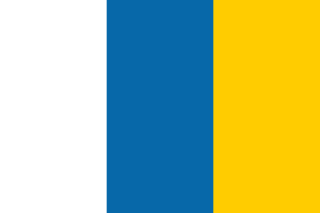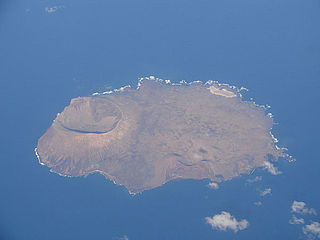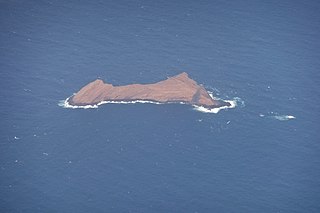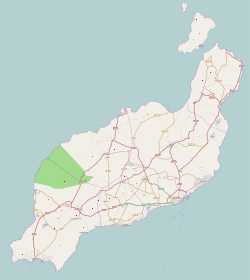
The Canary Islands, also known informally as the Canaries, are a Spanish region and archipelago in the Atlantic Ocean, in Macaronesia. At their closest point to the African mainland, they are 100 kilometres west of Morocco. They are the southernmost of the autonomous communities of Spain. The islands have a population of 2.15 million people and they are one of the outermost regions of the European Union.

Fuerteventura is one of the Canary Islands, in the Atlantic Ocean, part of the North Africa region, and politically part of Spain. It is located 97 km (60 mi) away from the northwestern coast of Africa. The island was declared a biosphere reserve by UNESCO in 2009.

Lanzarote is a Spanish island, the northernmost and easternmost of the Canary Islands in the Atlantic Ocean. It is located approximately 125 kilometres off the north coast of Africa and 1,000 kilometres from the Iberian Peninsula. Covering 845.94 square kilometres, Lanzarote is the fourth-largest of the islands in the archipelago. With 152,289 inhabitants at the start of 2019, it is the third most populous Canary Island, after Tenerife and Gran Canaria. Located in the centre-west of the island is Timanfaya National Park, one of its main attractions. The island was declared a biosphere reserve by UNESCO in 1993. The island's capital is Arrecife, which lies on the eastern coastline. It is the smaller main island of the Province of Las Palmas.

Arrecife is the capital city and a municipality of Lanzarote in the Canary Islands. It was made the island's capital in 1852. The city owes its name to the rock reef which covers its local beach. It also gives its name to the nearby Arrecife Airport. The population of the municipality was 64,645 in 2020. Its area is 22.72 square kilometres (8.77 sq mi).

Graciosa Island or commonly La Graciosa is a volcanic island in the Canary Islands of Spain, located 2 kilometres north of Lanzarote across the Strait of El Río. It was formed by the Canary hotspot. The island is part of the Chinijo Archipelago and the Chinijo Archipelago Natural Park. It is administrated by the municipality of Teguise. In 2018 La Graciosa officially became the eighth Canary Island. Before then, the island had the status of an islet, administratively dependent on the island of Lanzarote. The only two settlements on the island are Caleta de Sebo in the southeastern part of the island and summer-residence Casas de Pedro Barba.

Alegranza is an uninhabited island in the Atlantic Ocean, located off the coast of Africa and is in the province of Las Palmas in the Canary Islands, Spain. It is the northernmost point in the Canary Islands, and part of the Chinijo Archipelago. The island is part of the municipality of Teguise on Lanzarote.

Teguise is a municipality in the central part of the island of Lanzarote in the Las Palmas province in the Canary Islands. The population is 22,342, and the area is 263.98 km². It is located north of Arrecife and south of Haría. The seat of the municipality is the town of Teguise. The municipality also comprises a number of neighbouring islands including Graciosa, Alegranza, Roque del Este, Roque del Oeste and Montaña Clara.

Teguise, also known in Spanish as La Villa de Teguise, is a village in the municipality of Teguise in the north-central part of the island of Lanzarote in Las Palmas province in the Canary Islands. The town's population is 1,776 as of 1 January 2018.

The Chinijo Archipelago is a small archipelago located in the northeastern part of the Canary Islands, north of the island of Lanzarote. The archipelago includes the islets of Montaña Clara, Alegranza, La Graciosa, Roque del Este and Roque del Oeste. The archipelago is administered by Lanzarote and belongs to the municipality of Teguise. La Graciosa is the only inhabited island, with a population of around 700.

César Manrique Cabrera was a Spanish artist, sculptor, architect and nature activist from Lanzarote.

Roque del Este is a small uninhabited island in the Canary Islands, located 11 kilometres northeast of the island of Lanzarote. The island is part of the Chinijo Archipelago, which is administratively part of the municipality of Teguise.

Costa Teguise is a coastal town in the Municipality of Teguise on the island of Lanzarote. It was built intentionally to accommodate tourism, and prior to building commencing the streets were planned, constructed, and serviced in advance.

The timple is a traditional five-string plucked string instrument of the Canary Islands. It started being manufactured in the 19th century.

Caleta de Sebo is the main settlement and capital community of La Graciosa, Canary Islands.

Grainville-la-Teinturière is a commune in the Seine-Maritime department in the Normandy region in northern France.
Tourism is an essential part of the economy of the Canary Islands, a Spanish archipelago located in the Atlantic Ocean, 100 kilometres west of Morocco. Seven main islands and six islets make up the Canary Islands. They had more than 9 million foreign incoming tourists in 2007. Tourists seeking sunshine and beaches first began to visit the Canaries in large numbers in the 1960s. The Canary Islands are a leading European tourist destination with very attractive natural and cultural resources.

The Kingdom of the Canary Islands was a vassal state of the Crown of Castile located in North Africa, lasting from 1404 to 1448.

Charco del Palo is a naturist holiday village on the north-eastern coast of Lanzarote, in the Canary Islands. The village was established around 1970 by the German entrepreneur Gregor Kaiser. In due course, it has developed into a popular naturist resort. It was the first official naturist resort established in the Canaries: nudity is permitted everywhere in the village, and practised universally. Its isolated location, at the end of a dedicated three kilometer long access road, helps to achieve privacy, while the village remains open to all. Visitors are mainly German, British, and Dutch. The village's population increased from 82 in the year 2000 to 229 in 2011, it has subsequently declined to 156 in 2013.



















